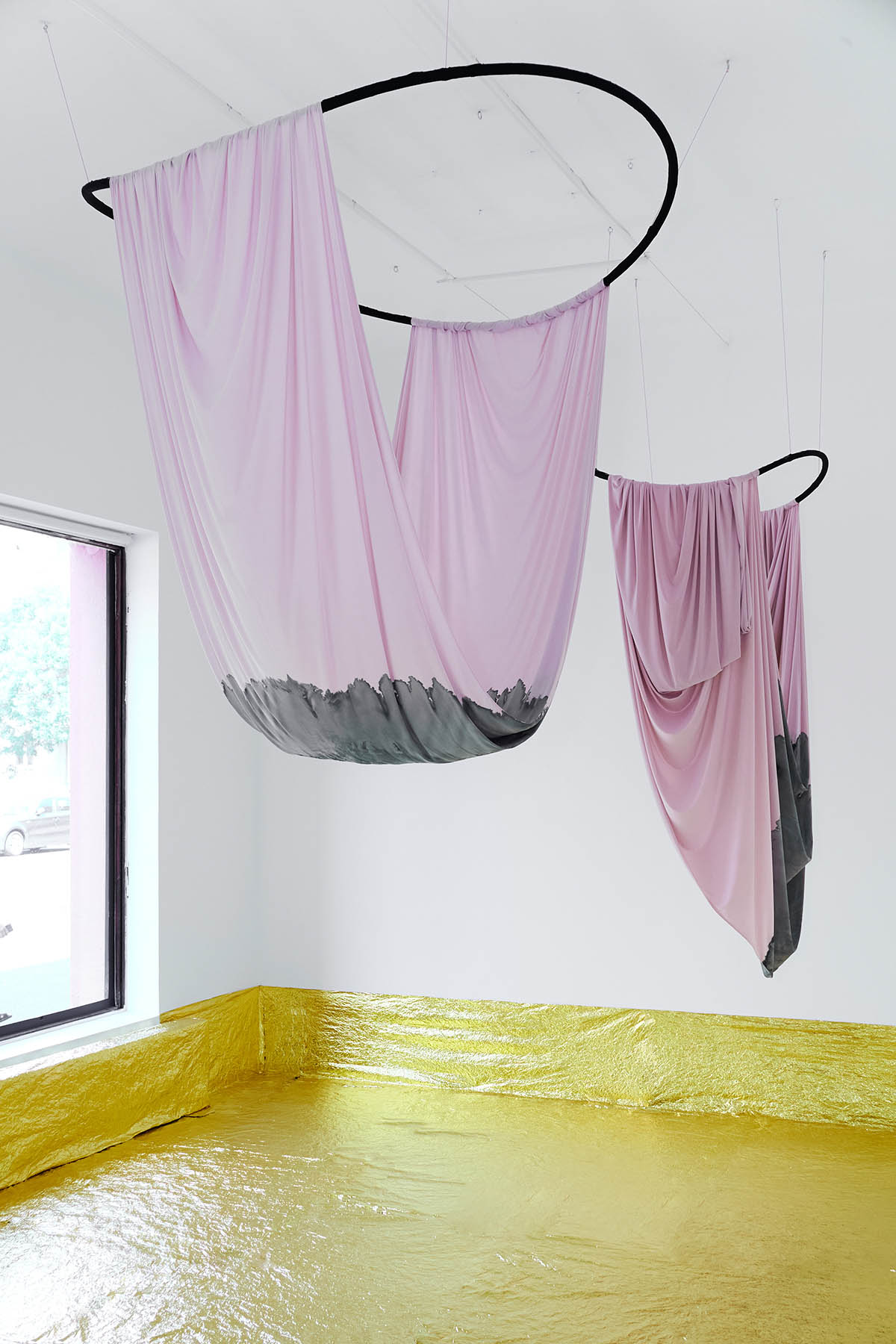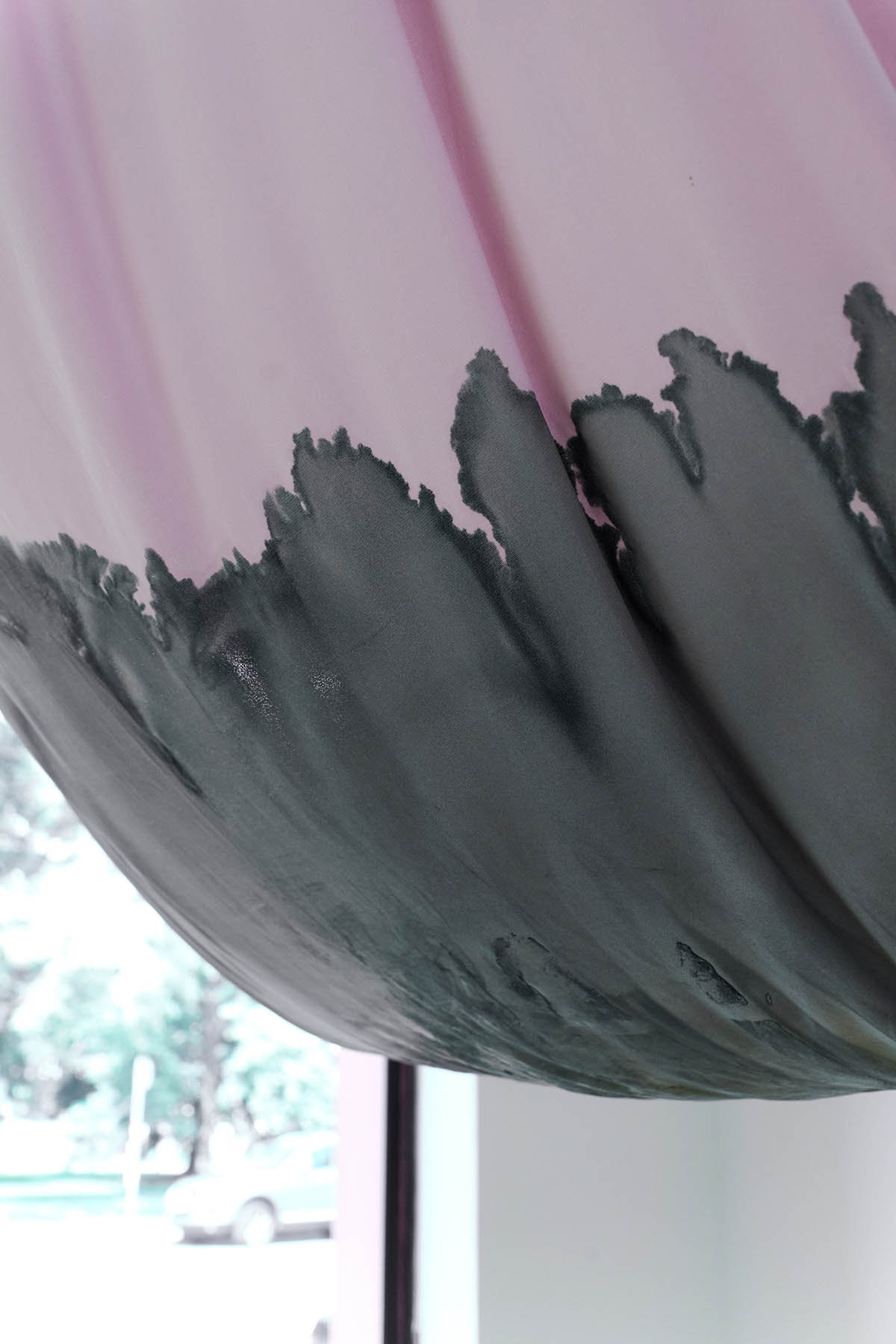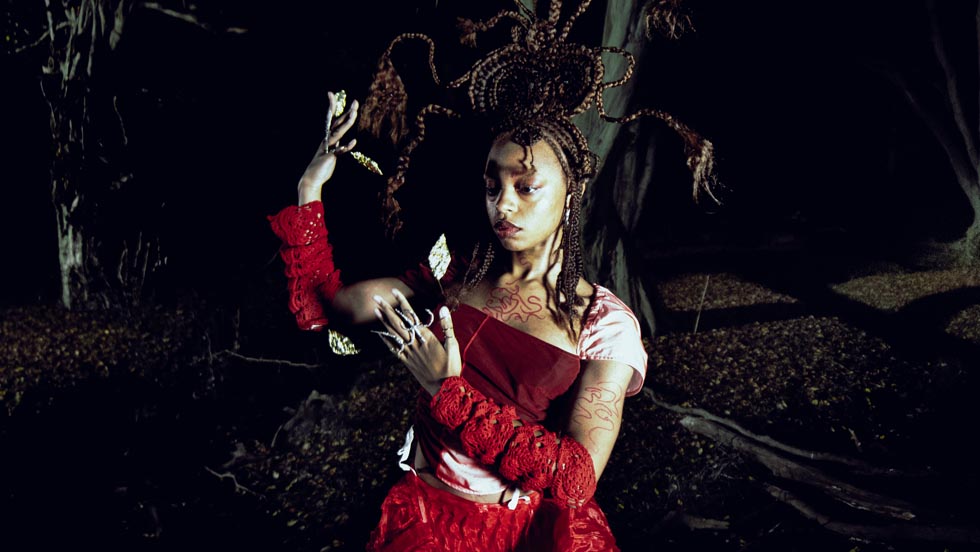
I would like to start with the Chamber Exhibition Series. Can you tell us about the preparations? Here you are exhibiting Chamber II, so the second part. What about the first one, and how did it all start?
The Chamber was situated in the Red Carpet Showroom on Karlsplatz. I work site-specific, so I always try to use the space to its maximum. I have been working on the topic of the ancestral family line for a very long time, especially last year when I had a residency from Raw Matters. During this working time, I started using various methods to reach somatic memory, and it happened that I came to this really specific image of being blinded by the intense light. In this very first session of working with my somatic memory, I felt this big female energy, and when I say female, it doesn’t mean it is coming from a female person; it is more about the energy I felt. In these processes, I always lose sight of gravity. I work a lot with my body, so this method of working brings me a lot of movements and pictures. And then this feeling stayed very deep in me, and I didn’t know what to do with it. I thought, at this moment of encounter, let’s bring it into the material space, and because of my big interest in archeology, I connected this ancient energy to the wall cave paintings “La Pintada” in Northern Mexico. There were intergenerational paintings of different generations of one family in constant migration, going and coming back. And then the idea of the cave happened, and that’s why Chamber became the name of the series. The numbers next to the title represent how deep inside the cave you are. It is a linear perspective in this sense. What I kept from the first Chamber exhibition was this reflective floor, but now, for a difference, visitors are also interacting with it and being part of the exhibition through the noise they are making while moving.
This is also something I will incorporate into a performance that is part of this exhibition, Chambers II.



Your performance practice is a very important part of your artistic practice. Can you tell us what we could expect from the performance that is happening from June 18th to June 19th here in Mz*Baltazar’s Laboratory? Since it is a durational piece, not every moment of it could be planned, but tell us what your plans and wishes are for it.
In the beginning, I will be using the techniques that I normally use during my working sessions when it comes to somatic memory. I will put myself in a psychological state where I will be able to look deeper inside myself. The process is in some way related to autohypnosis, but I do a lot of meditation and breathing techniques. I have been doing meditation for ten years and practicing body techniques for twenty years, so I know how these techniques work with my body. And there is a specific technique that is called Tamalpa, where you ask yourself a question and then try to give yourself an answer with movement, drawing, and writing. For the exhibition itself, I realized during set-up that I couldn’t decide on the final pattern for the drawing on the wall, so I made one figure that still needs development. I assume that the wall painting needs to grow, and I hope that it will happen during the performance. Some sort of goal of the performance is to realize which one is the shape of me on the wall of the cave. The acoustics of the space are magical and similar to those in the cave, so I will work with them as well. I will work on the sound that the floor is making and the sound of my voice in an abstract way.



How restrictive will you be of your physical needs when it comes to performing for 24 hours?
In this case, I will not restrict myself to these basic needs because this performance is not about my physical experience but about my mental experience. If I force my body into some restrictions, I automatically restrict my mind. And I want to do the opposite. I want to free up my mind and let my body do what it needs to do next to it. It could be that I am putting myself in uncomfortable positions, but it will be the outcome of my mind and what it needs at the moment.

How important is the audience to your performances?
I love and enjoy the audience; it is very important to me, especially when I do short pieces where everything is more planned and choreographed from my side, even though I am still leaving room for surprises for myself. So in general, for shorter pieces, I know what I am offering to the people who are there to see it. This 24-hour performance will be more like putting myself naked on the street. I don’t know what exactly is going to happen. I have ground rules and a basic frame, but I am letting myself be. In this performance, I would say that the audience is important, but I will be more focused on my experience. I am sure that when visitors are there with me in the space, it will have an impact on me. I think it will be very interesting to see me going through a process. and I am very excited about it.
The audience is going to see me going through a process. There are different opening hours, and my state will be different every hour.

When you would need to explain your practice in one word or a sentence what it would be?
I am calling my works performative landscapes because the audience must not be passive; I am focused on always giving them an active role, and they are somehow performing together with the objects or together with me. Here, I am giving them the feeling of walking together on a tin surface. On something fragile. To go back to the idea of the cave, I think that it has one life or one kind of existence when it is empty and alone and another when people are inside. It transforms into something else with life and noises, just like here, where every time someone comes, it activates the room.
How significant an impact will this performance have on your future works, and how will you be documenting and „digesting“ your experience while performing and turning it into something later? Do you remember everything that happens during your performances in general?
I often work in series, and it is not only because I have been obsessed with some materials for some time but also because of this way of processing stuff I experience. Some stuff is following me so strongly that it takes a long time until it crystallizes. I don’t remember every little detail from each performance, but there are a lot of moments that stay with me forever. For example, there is a black mirror in this exhibition. I have been working with charcoal since 2009, and it has been something I have been experiencing for a long time with different fluids and so on, and in the end, it served me to make a reflection surface in the art space.


When you first started painting, did you have the idea that you would become a multidisciplinary artist, or were you more focused on the two-dimensional space of a painting? There’s still drawing in your work, but is there still this tradition in a traditional sense, like painting on canvas? Is this still happening? How did you come to the decision that you are studying art at all? Is that something that was following you from early on in childhood, or did it just develop in the early teen period?
I started drawing because, since I was small, other kids were running around with puppets, and I was running around with a pen and paper. So drawing was always very important to me, and I was lucky enough to get a scholarship to go to the drawing and painting academy when I was nine. There I learned all these formalist, academic, and technicalities, and I tried them or kind of mastered them in a way I got through almost ten years of training. I made very academic paintings, was always strict with myself, and always tried to imitate reality as much as possible. And that was frustrating me at one point because I knew that it would never be perfect enough to completely reflect what I was experiencing.

But this is very interesting: how you came, then later, how you turned around like 180 degrees, saying, Okay, I want to do something opposite from there.
Yeah, that comes from the period of studying conservation and restoration, as well as archeology, and that resulted in having a bigger concept behind the work. There was an opportunity to study stone conservation in Germany, and this is why I moved to Europe in the first place. It all started when I was studying conservation and working on the restoration of ancient caves and exploring the wall paintings inside.
Do you work in a studio? What does your working process look like?
I am sharing a studio with the other artists, but I have two studios. Next to the one where I paint and make my objects, I have my studio for performative processes where I prepare my performances but also do these somatic “trips”, let’s say. and they’re there. There I take notes and make drawings, and there it’s more about the experience, and there I also have a dance floor, so there is a focus on the body and movement the most. In my artist studio, I paint when I know what I want to paint. There I use a lot of liquid for my watercolors, I like the feeling that the water is still alive and it can transform the work, and I am not in control of it. So this is a mix between what I want and what happens. Often, I also use colors that “hate” each other on a chemical basis, so the magical stuff can happen on paper due to this reaction. So I am also using some tricks from my material studies.

We talked in the beginning about this female energy that it’s not connected to, then the gender politics open or like gender issues or bodily experiences, but as I strongly believe, someone who maybe doesn’t know your work or it’s like their first time seeing your work could think that it has some kind of feminism to it.
I would say I do see myself as a feminist, but in a queer – intersectional feminist frame because, for me, it’s very clear that, as a Mexican migrant person in Europe with a Mexican family in the US, I am very much aware of the many layers of complication and other ideas of humanism and humanity, which are important as well as feminism. It is often about transitioning into a different environment. But this is exactly part of the intersectionality, right? It’s not “just” about being female, but perhaps not being white, perhaps not coming from a rich family. For me, it was always about humans growing together—not destroying each other, but trying to grow together and support each other.

Give us a glimpse of what is to come, and what are the next occasions where we can see your work?
On September 21, 2024, I will give a workshop with artist-curator Negin Rezaie at MUMOK in the frame of the exhibition Avantgarde and Liberation. The workshop series is a cooperation with curator Heidrun Schulze, and I was also invited by curator Marcello Farabegoli and director Julia Moebus-Puck to perform at the WAM – Wiener Aktionismus Museum during the Viennese „Lange Nacht der Museen“ on October 5, 2024.
Currently on view: Chamber II: reflecting river
Exhibition duration: 07.06. – 21.06.2024
Performance: 18.06 from 18:00 and on the 19.06 from 10:00 to 12:00 and from 15:00 to 16:00
Address and contact:
Mz*Baltazar’s Laboratory
Jägerstraße 52-54, 1200 Vienna
www.mzbaltazarslaboratory.org
Guadalupe Aldrete – www.guadalupealdrete.com, www.instagram.com/guadalupe_aldrete
In “chamber II: reflecting river”, Guadalupe visits and explores a personal landscape discovered by herself in her somatic memory. Relevant visual elements and movements take form in this exhibition, in which she interconnects her own imagination with actual archaeological finds located in the caves of northern Mexico, the place she considers to be the earliest connection to her ancestors. While connecting seemingly opposite landscapes, she points out the multiplicity of realities crossing through a single ancestral family line.
Guadalupe Aldrete creates performative landscapes using a transdisciplinary approach. Her current focus lies in exploring ancestral relationships among family members and the immaterial heritage passed down through generations. In her works, she tries to catch glimpses of our ability to transcend, inviting us to observe our own stories and inspiring dialogue and reflection on the interconnectedness of the past, present, and future. Her work has been showcased internationally, including at the Infinite Present festival in Ljubljana (2024) and in solo exhibitions like “Diluidos” at the Michaela Stock Gallery, Vienna (2018) or “Un Pueblo” at Eindorf Kunst Raum (2023). She’s been commissioned for the inauguration of the Croatian Museum for Modern and Contemporary Art (MMSU) in Rijeka (2018) and for PCP at the Science Gallery London (2023). Aldrete was a resident at the Austrian Frauenmuseum Hittisau (2021) and the Lushan Art Museum in China (2018). In 2023, she was holder of the TQW “Stipendium Körper- & Performancepraktiken.“





